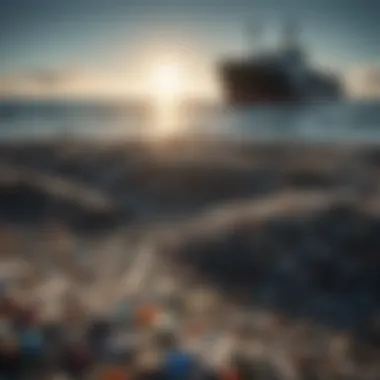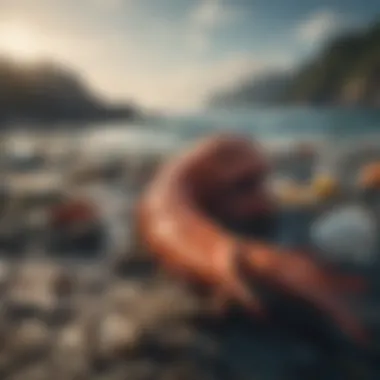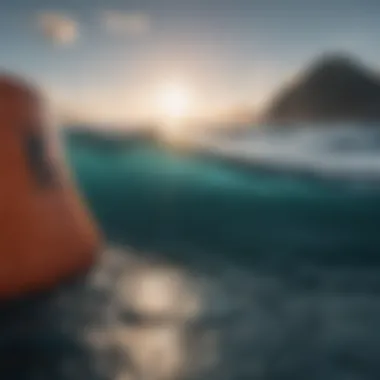Unveiling the Menacing Reality of the Pacific Ocean's Floating Island of Garbage


Information and Overview
Let's delve into the daunting reality of the floating island of garbage in the Pacific Ocean, exploring its origins, environmental impact, and potential solutions. In a world grappling with extensive plastic pollution's consequences, comprehending the scale and implications becomes vital for environmental conservation and sustainability efforts.
Addressing the Origins
The origins of the floating island of garbage trace back to human activities, primarily improper waste disposal and ocean currents. Masses of discarded plastic, debris, and waste conglomerate to form this vast expanse of pollution. Understanding the chain of events that led to this environmental crisis sheds light on the urgency of the situation.
Environmental Impact Assessment
The environmental impact of this floating garbage island is dire, affecting marine life, ecosystems, and even climate patterns. Plastics degrade into microplastics, endangering aquatic creatures and bioaccumulating through the food chain. The disruption caused to the ecosystem reverberates across the globe, emphasizing the interconnectedness of environmental systems.
Evaluating Potential Solutions
Exploring potential solutions to address this pressing issue involves a multi-faceted approach. Raising awareness, implementing stringent waste management practices, and fostering global cooperation are crucial steps. Technologies for cleaning up oceanic waste, such as ocean cleanup systems, also play a pivotal role in remedying the situation.
Conclusion and Reflection
Synthesizing the information presented throughout underscores the urgent need for collective action against plastic pollution and environmental degradation. Recognizing the gravity of the floating island of garbage prompts reflection on individual responsibilities and the larger impact of human actions on the planet. Together, we can embark on a sustainable path towards preserving our oceans and safeguarding future generations.
Introduction
Overview of the Issue
Magnitude of the Problem
At the epicenter of this environmental catastrophe is the sheer scale of the garbage island, spanning thousands of square kilometers. The relentless accumulation of plastic debris and chemical contaminants poses a severe threat to marine life and ecosystem equilibrium. Understanding the magnitude of this predicament is crucial in sparking proactive measures and fostering a global shift towards sustainable practices.
Geographical Location
Located within the heart of the Pacific Ocean, the floating island serves as a glaring reminder of the far-reaching consequences of human activity. Its strategic position reflects the interconnectedness of environmental degradation on a planetary scale. Examining its geographical relevance sheds light on the broader implications of neglect and serves as a call to action for conscientious conservation efforts.
Significance of Addressing the Problem
Environmental Impact
The environmental repercussions of this floating garbage menace are profound, affecting marine biodiversity and ecosystem resilience. The toxic legacy left in the wake of human consumption habits poses a direct threat to the delicate balance of our oceans. Addressing this impact is not merely a choice but a vital necessity for safeguarding the future of our planet.


Marine Life Endangerment
The endangerment of marine life due to the floating island underscores the urgent need for intervention. From entangled sea creatures to ingested plastic particles, the repercussions reverberate across all levels of the ocean's food chain. Preserving marine habitats and species diversity hinges on our ability to confront this crisis head-on.
Connection to Human Activities
Plastic Consumption Patterns
Unveiling the intricate web of plastic consumption patterns reveals the stark link between human behavior and environmental degradation. The pervasive reliance on single-use plastics and unsustainable packaging practices directly fuels the proliferation of oceanic garbage. Acknowledging and reshaping these patterns is pivotal in steering towards a more sustainable future.
Waste Disposal Practices
Examining prevailing waste disposal practices unearths the systemic flaws perpetuating the garbage island phenomenon. From inadequate recycling infrastructure to irresponsible dumping, human actions play a central role in perpetuating this ecological disaster. Rethinking waste management strategies is a cornerstone in mitigating the far-reaching impacts of our disposable culture.
Understanding the Origins
In delving into the disturbing realm of the Floating Island of Garbage in the Pacific Ocean, understanding its origins serves as a pivotal starting point. This segment of the article shines a light on the crucial factors that led to the formation of this colossal expanse of waste. By comprehending the beginnings of this environmental crisis, we can grasp the root causes and implement more effective strategies to combat its detrimental effects. The insights gained from unraveling the origins of this floating mass provide a solid foundation for devising sustainable solutions and fostering a global commitment to environmental preservation.
Historical Background
Development Over Time
Exploring the historical trajectory of the floating garbage island reveals a staggering evolution over the years. The gradual build-up of plastic waste intertwined with other debris underscores the long-standing negligence towards marine ecosystems. This historical context illuminates the exponential growth of the garbage island, highlighting the insidious effects of human activity on the world's oceans. Understanding the development over time unveils the cumulative impact of plastic pollution, emphasizing the urgent need for proactive measures to mitigate its consequences.
Contributing Factors
Analyzing the contributing factors to the formation of the garbage island unveils a web of interconnected elements. From industrial practices to consumer behaviors, various factors have played a role in exacerbating this environmental challenge. Identifying these contributing factors offers a critical perspective on the multidimensional nature of the issue, calling for a holistic approach towards addressing plastic pollution. By examining the diverse influences at play, we can develop targeted interventions to combat the root causes of this pervasive problem.
Transportation Mechanisms
Ocean Currents
The role of ocean currents in shaping the floating island of garbage cannot be overstated. These powerful natural forces act as conveyor belts, transporting debris across vast distances and accumulating them in specific regions. Understanding the dynamics of ocean currents sheds light on the movement patterns of plastic waste, highlighting the interconnected nature of marine pollution. By deciphering the influence of ocean currents, we gain valuable insights into the distribution and concentration of plastic debris, shaping our strategies for effective cleanup and prevention initiatives.
Human Intervention
Human intervention has emerged as a significant catalyst in the proliferation of the garbage island phenomenon. Whether through improper waste disposal practices or active dumping at sea, human actions have directly contributed to the escalation of marine pollution. Examining the impact of human intervention underscores the importance of adopting sustainable behaviors and enforcing stringent regulations to curb plastic contamination. By addressing the role of human activities in exacerbating this crisis, we can pave the way for a more responsible and environmentally conscious approach to waste management.
Composition of the Garbage Island


Plastic Debris
At the core of the garbage island lies a pervasive presence of plastic debris, posing a severe threat to marine ecosystems. The prevalence of plastic waste, ranging from microplastics to large fragments, underscores the alarming scale of pollution in our oceans. Exploring the composition of plastic debris unveils the diverse sources and types of materials contributing to this environmental hazard, emphasizing the need for comprehensive removal and prevention strategies. By dissecting the characteristics of plastic waste within the garbage island, we can navigate towards more sustainable practices and promote circular economy initiatives.
Chemical Contamination
Beyond plastic debris, the garbage island harbors a cocktail of chemical contaminants that further intensify its environmental impact. From toxic leachates to hazardous substances, the presence of chemical contamination poses risks to both marine life and human health. Examining the composition of chemical contaminants elucidates the complex interplay between pollutants and ecosystems, underscoring the critical imperative for remediation and pollution control measures. By addressing the sources and implications of chemical contamination, we can work towards safeguarding the integrity of marine environments and preserving biodiversity for future generations.
Environmental Implications
Ecosystem Disruption
Toxicity Levels
The Toxicity Levels subsection within Ecosystem Disruption uncovers the sobering reality of the contaminants present in the floating island of garbage. The toxicity levels exhibited by the debris pose a significant threat to the marine ecosystem, affecting the health and survival of various species. By exploring the specific chemical compositions and their detrimental effects, readers gain insight into the severity of the pollution crisis. Understanding the impact of toxicity levels is essential in devising effective cleanup and prevention measures to safeguard marine biodiversity.
Habitat Destruction
The Habitat Destruction aspect under Ecosystem Disruption underscores the physical alterations caused by the floating garbage on marine habitats. As plastic waste accumulates and drifts across the ocean, it disrupts the delicate balance of underwater ecosystems, threatening the existence of marine species and compromising biodiversity. By elucidating the degradation of habitats and its cascading effects on food chains, this section emphasizes the need for immediate conservation efforts. Addressing habitat destruction is paramount in preserving the natural balance of the marine environment and ensuring the sustainability of oceanic ecosystems.
Climate Change Effects
Carbon Footprint Impact
Within the Climate Change Effects portion, the discussion revolves around the carbon footprint impact resulting from the floating island of garbage. The release of carbon emissions due to plastic production, degradation, and incineration contributes to global warming and environmental degradation. By examining the carbon footprint implications in this context, readers gain insight into the broader consequences of plastic pollution on the planet's climate. Recognizing the link between waste management practices and climate change is pivotal in formulating comprehensive solutions to combat the environmental crisis.
Altered Oceanic Conditions
The Altered Oceanic Conditions segment within Climate Change Effects sheds light on the various ways in which the presence of the garbage island affects ocean ecosystems. From shifts in sea temperature to disruptions in nutrient cycles, the altered conditions influence marine life and exacerbate environmental disturbances. By elucidating the interconnected relationship between plastic pollution and oceanic changes, this section underscores the urgency of adopting sustainable practices to mitigate adverse impacts. Understanding the altered oceanic conditions equips readers with knowledge crucial for promoting environmental resilience and combating climate change.
Global Consequences
International Collaboration Needs
The International Collaboration Needs section underscores the necessity of global cooperation in addressing the challenges posed by the floating island of garbage. Collaboration among nations, organizations, and individuals is essential to implement cohesive strategies for waste management and pollution control. By emphasizing the importance of international partnerships and joint initiatives, this segment advocates for collective action to combat the environmental crisis effectively. Recognizing the significance of collaboration fosters a sense of shared responsibility and solidarity in tackling global environmental challenges.
Policy Implementation Challenges
The Policy Implementation Challenges component delves into the complexities of enacting and enforcing regulations to confront ocean pollution. From regulatory hurdles to enforcement limitations, policymakers face various obstacles in implementing effective measures to combat the environmental crisis. By examining the challenges associated with policy implementation, readers gain insight into the underlying issues hindering progress towards sustainable waste management. Addressing policy challenges requires innovative solutions, stakeholder engagement, and continuous evaluation to enhance environmental protection measures and ensure regulatory effectiveness.


Mitigating Strategies
Mitigating strategies play a crucial role in addressing the menace of the floating island of garbage in the Pacific Ocean. These strategies encompass various elements aimed at reducing the impact of plastic pollution on the marine environment. By focusing on innovative solutions, implementing proper waste management practices, and raising awareness about sustainable consumption, mitigating strategies can help combat this pressing environmental issue effectively. Emphasizing the need for concerted efforts from individuals, organizations, and governments, these strategies aim to mitigate the detrimental effects of plastic waste on marine ecosystems and wildlife.
Technological Innovations
Ocean Cleanup Initiatives
Ocean Cleanup Initiatives represent a groundbreaking approach to tackling the accumulation of plastic debris in oceans. By employing cutting-edge technologies such as floating barriers and autonomous cleanup systems, these initiatives aim to remove large quantities of plastic waste efficiently. The key characteristic of Ocean Cleanup Initiatives lies in their ability to target areas with high concentrations of marine debris, thereby maximizing the effectiveness of cleanup efforts. Despite facing challenges such as operational costs and logistical complexities, Ocean Cleanup Initiatives offer a promising solution to mitigating the impact of plastic pollution on marine ecosystems.
Advanced Recycling Methods
Advanced recycling methods hold significant potential in reducing the amount of plastic waste that ends up in the ocean. By utilizing innovative techniques such as chemical recycling and pyrolysis, these methods enable the conversion of plastic waste into valuable resources, promoting a circular economy approach. The key characteristic of advanced recycling methods lies in their capacity to transform complex plastic materials into high-quality raw materials for new products. While facing challenges related to scalability and cost-effectiveness, advanced recycling methods offer a sustainable approach to managing plastic waste and reducing environmental impact.
Educational Campaigns
Plastic Awareness Programs
Plastic awareness programs play a vital role in educating the public about the implications of plastic pollution and fostering responsible consumption habits. By raising awareness about the sources and consequences of plastic waste, these programs aim to inspire individuals to reduce their plastic footprint and adopt eco-friendly alternatives. The unique feature of plastic awareness programs lies in their ability to engage diverse audiences through interactive workshops, awareness campaigns, and community events. Despite challenges such as information dissemination and behavior change, plastic awareness programs contribute significantly to proactive efforts in combating plastic pollution.
School Curriculum Integration
Integrating environmental education into school curricula is essential for instilling sustainability principles in the younger generation. By incorporating topics related to marine pollution, recycling, and waste management into educational programs, schools can empower students to become advocates for environmental conservation. The key characteristic of school curriculum integration lies in its capacity to cultivate environmental consciousness from an early age, shaping future leaders with a strong sense of environmental responsibility. Despite logistical hurdles and curriculum constraints, school curriculum integration plays a pivotal role in nurturing eco-conscious individuals and driving positive environmental change.
Legislative Actions
Bans on Single-Use Plastics
Bans on single-use plastics represent a crucial legislative intervention to curb the production and consumption of disposable plastic products. By prohibiting the use of items such as plastic bags, straws, and utensils, these bans aim to reduce plastic waste generation and promote sustainable alternatives. The key characteristic of bans on single-use plastics lies in their ability to prompt widespread behavioral change and encourage the adoption of reusable and biodegradable alternatives. While facing challenges related to enforcement and stakeholder resistance, bans on single-use plastics offer a significant step towards mitigating the plastic pollution crisis.
Extended Producer Responsibility
Implementing extended producer responsibility (EPR) policies holds industries accountable for the entire life cycle of their products, including post-consumer waste management. By requiring manufacturers to take responsibility for recycling and disposal schemes, EPR policies incentivize eco-friendly design and resource conservation. The unique feature of extended producer responsibility lies in its potential to drive product innovation towards sustainability and promote a circular economy model. Despite complexities in implementation and regulatory frameworks, EPR policies offer a systematic approach to reducing plastic pollution and encouraging corporate sustainability initiatives.
Conclusion
Call to Action
Individual Responsibilities
Embarking on a journey towards sustainability necessitates acknowledging our role as individuals in combating environmental challenges. Our daily choices, from the products we use to how we dispose of waste, play a significant part in mitigating plastic pollution. Embracing individual responsibilities empowers us to make conscientious decisions that contribute to the greater good. By reducing single-use plastics, adopting eco-friendly practices, and advocating for change, we can foster a culture of sustainability. The key characteristic of individual responsibilities lies in its transformative impact on our environment and communities. It instills a sense of accountability and encourages proactive engagement in environmental conservation efforts. While the road may be challenging, the rewards of embracing individual responsibilities are profound. By making sustainable choices, we not only reduce our ecological footprint but also inspire others to follow suit, creating a ripple effect of positive change.
Collective Environmental Consciousness
At the heart of addressing the floating island of garbage lies the concept of collective environmental consciousness. This collective mindset transcends individual actions, emphasizing the power of united efforts in safeguarding our planet. Collective environmental consciousness is the convergence of shared values, collaborative initiatives, and a commitment to environmental stewardship. By fostering a sense of community and amplifying our impact through collective actions, we can drive meaningful change on a global scale. The key characteristic of collective environmental consciousness is its ability to mobilize diverse stakeholders towards a common goal. It ignites a sense of solidarity and collective purpose, uniting individuals, businesses, and governments in a concerted effort to combat plastic pollution. While the challenges of collective action may be daunting, the benefits far outweigh the obstacles. By cultivating a collective environmental consciousness, we pave the way for sustainable practices, policy reforms, and a brighter future for our oceans and planet.















